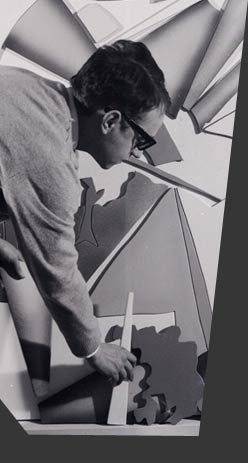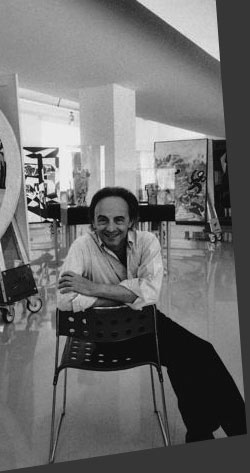Flaminio Gualdoni
UGO NESPOLO:1968 AND SURROUNDINGS
"Nespolo est ambitieux, Nespolo est jaloux, Nespolo est hypocrite, Nespolo est mèchant, Nespolo est menteur et rusè, Nespolo est dèvorè de pretention. C'est un loup. Il se porte bien".
With these words paradoxically affectionate and auspicious Ben Vautier greets Ugo Nespolo, with who he shares the militancy of the Fluxus and the bypass, the climate recovery paradoxical and vaguely legendary of Marcel Duchamp and of the radical gesture with the behaviour an artist in which is not clear what they want to be, but very clear what they do not want to be.
The debut of Nespolo has just been, with events in Turin such as "La logica del puzzle" and "In me, rompersi sento immagini di sogno", but mostly with a movie, Grazie mamma Kodak, fifteen minutes in a silent Super8, that prelude to a crucial biennium 1967/1968 in which the entire artistic panorama will be released completely changed.
A brief list to understand l'air du temps: in 1967 exhibitions like these are held in Italy "Arte povera + Im-spazio" at the Bertesca in Genoa, with Boetti, Fabro, Kounellis, Paolini, Pascali, Prini, Bignardi, Ceroli, Icaro, Mambor, Mattiacci, Tacchi; "Esperienza" at the Theatre in Via Belsiana in Rome, where they presented their experimental films Schifano, Angeli, Festa, Gerard Malanga, Patella; "Lo spazio dell'immagine" at the Trinci Palace in Foligno with artists like Fontana, Castellani, Bonalumi, Colombo, De Vecchi, Scheggi, Mattiacci, Pascali, Pistoletto, Gilardi, Fabro; and again "Fuoco immagine Acqua Terra" at the "Attico di Roma", "Il tempo dell'immagine" at the Civic Museum of Bologna, the "International exhibition of concrete poetry" at the Donizetti Theatre of Bergamo, the "Experimental Museum of contemporary art" at the Modern Art Gallery in Turin, "Nuove tecniche d'immagine" at the Biennial of San Marino, "Parole sui muri" in Fiumalbo.
Nespolo is in the game, from the start, right in the rare and pioneering Fluxus activities that mark this year.
On March 9 1967, he presents at the Sala delle Colonne of the Stabile Theatre, his Puzzles during the event "Proposte" wanted by Paolo Fossati, Guido Davico Bonino, Leo Pestelli and Ippolito Simonis, three evenings of "anthologic entertainment"- so the organizers - who combine music, literature, theatre, experimental art: from Ernesto Ferraro to Giulio Paolini, from Riccardo Vianello to Nico Orengo, from Progressive Jazz Quartet to Sebastiano Vassalli, from Luciano Fabro to Alessandro Lauri.
A month later, between the 26th and the 28th of April, there he is operating within "Les mots et les choses". Concert Fluxus art total" between The Punto Gallery and The Theatre Stabile of Turin, before a triad of events (the others will take place at the Bertesca in Genoa on the 6th of June and at the International art club in Lugano on the 11th of November) in which he is action protagonist with Sergio Albergoni, Gianni Sassi, Gianni-Emilio Simonetti, Daniela Palazzoli, leaders of one of the most sharp avant-guard stories of that period.
The quartet of companions for life is the master, in that same year, of the foundation of the publishing house ED912 and of the magazine "Bit" pioneering paper with others that came out in that same period (Flash that will become Flash art, Cartabianca and Nac a couple of months later) distinguished by "poor" graphic, of exceptional quality and for the ability of Palazzoli and Simonetti to intercept, accomplice a drafting committee which included Germano Celant, Mario Diacono, Tommaso Trini and Marisa Volpi, the tensions between vitalism, dadaist and situationist, at the time extraneous to the italian debate: in which, it is good to remember, only a few authors evaded the burden of new opticalfilm archieves and pop.
From the atypical of Nespolo become aware, as well as the Fluxus group, the poet Edoardo Sanguinetti, that established a collaboration with the artist intended to last until today, and in a critic ambit Renato Barilli, who in May 1967 in the article Four artists selected by Barilli n. 9 of "Op.cit", indicates him as a authority reality of the new research, alongside Piero Gilardi, Valerio Adami and Sergio Vacchi. Writes Barilli for Nespolo "context of pure artificiality", where, setting aside every mimetic purpose, intelligence plays an uncovered game, given himself to violent actions and manipulations: dismemberment of images, cut-outs and their dislocations, free and ingenuous combinations, in the name of the "complacent establishment" and stunted of a pure artificial arrangement".
It's an exhibition organized by Palazzoli to contextualize and emphasize the autonomy of Nespolo, compared to popism and to current objectivity, where certain external verses would be attributed to him. In "Per un'ipotesi di Con temp l'azione" 1967 December 4th, at the Stein, Il Punto and Sperone Galleries, Nespolo is with Alviani, Anselmo, Boetti, Fabro, Mondino, Piacentino, Pistoletto, Scheggi, Simonetti, Zorio. And also, this time the reading of his work is intellectually alienating of the artifice: "Nespolo's objects have provocative effects. They measure information, the novelty of an effect compared to the alienating use (surreal) of it's factors. They use artificial systems to produce effects that are not relevant to their common maintenance: tubes that conduct air, phones that trasmit the sound of power, and so on. The distance between the technological object which we propose and it's proper use is the measure of information and in this way the artistic contextualisation makes attendance in which, to a maximum of unstable meaning ambiguities corresponds an absolute criticism.
Besides creating the first objects of a sardonic and caustic mechanical celibate, that will find full expression in the exhibition of 1968 and beyond. Nespolo continues with the experimental cinema, increasingly elucidating another one among the ways of substantial continuity, while the historical avant-garde -Futurism- that later will become the polar star of his work - surrealism at the top.
In those same months, come to life "La galante avventura del cavaliere dal lieto volto", resounding pastiche between the echos of Dada and situationist assembly starring Lucio Fontana, Enrico Baj, Renato Volpini, the more linguistically focused "Le gote in fiamme" and "Neonmerzare", with the neonâs of Mario Merz that announces shortly thereafter their arrival, and that are confirmed convincingly in Europe, at that time, only with the works of Gerry Schum: dated 1968 are infact evidenced "Boettinbiancoenero", with Alighiero Boetti, artist in that period with the closer linguistic relation with Nespolo, "Tucci-ucci" with Tucci Russo, "A.G." with Allen Ginsberg and "Buongorno Michelangelo" with Pistoletto.
Starting the 7th of September until the 13th takes place in S. Benedetto del Tronto the Week of Independent Cinema, to whom takes part Nespolo with Angeli, Baruchello, Berger, Buggiani, Capanna, Conner, Elia, Ferraro, Grifi, Leonardi, Menzio, Patella, Piccardo, Schifano, Tuti, Vergine and pioneers and historical masters like Richter, Munari and Veronesi. Although the experimental aspect prevails largely on the technical quality of the operations, it is from the point of view of the exploration of the expressive possibilities and from the rising radicalism visual and mediatic, that such experiences - those of Nespolo art the most influential - find their primary reason to be.
Fernanda Pivano reiterates it well in an article 'Manovelle fuori canale' dedicated to the italian avantgarde "film makers", published in 1969 in "Domus"477.
The year after Nespolo is back in S. Benedetto with "Al di là della pittura", but with a preference for the section "Esperienze artistiche al di là della pittura" with Alfano, Alviani, Calzolari, Ceroli, Contenotte, De Vecchi, Kounellis, La Pietra, Marotta, Mattiaci, Merz, Mondino, Nannucci, Panseca, Patella, Pirelli, Pisani over the one for "Independent Cinema".
The real turning point in Nespolo's process occuried on March 5, 1968, with his personal exhibition at the Schwarz Gallery in Milan, that makes him an eminent figure in a glimpse of that decade. The artist presents what Pierre Restany calls in the intro text "machines - objects conditionnelles", in which the logic of the puzzle - that he is experiencing and that years after will become his lush and lavish visions - involves a mechanism of decomposition and recomposition of objects that undergo an estrangement between structure and function, between expectation and appearance, between what evolves in terms of fashion ans aesthetic displacement artificially produced.
So, it's good to remember, in the season where it reaches it's peak, in the world of design, the debate between nude functionalism and the suggestion of specific beauty of the useful object. Witness of this moment is the double series of drawings, owned by Artur Schwarz and never exposed, that Nespolo in 1968-1969 creates in a proliferation of ideas, solutions, phantasmagorias, typical of that moment.
Technical structures and physical behaviours, improbable automatisms and playful appearances, useless machines and distorted functionality to the drift of sense. All this in a kind of Pop Leonardism with a return to a clamorous Max Ernst and a bewildering pataphysic brought to a paradoxical humour. Objects and forms of Nespolo live in the conditional and not in indicative. They affirm their presence, do not impose themself as such. Instead they suggest their potentiality in a dimension space-time in which - once integrated - will assume their full meaning, sharply writes Restany.
And Trini, in a letter published in "Casablanca" in May 196, observes that Nespolo "acts on the reason for things more than on the things" and "points at the estrangement: it is the control of the effects caused by a sense of subversion".
In addition to the creations presented by Schwarz, shortly thereafter in "Molotov". Three works for a non-generic exhibition at The Punto, and especially in these papers, in which the inventor an Boetti, find multiple cues of reciprocal suggestions, to fully read the first soul of Nespolo.
(From the magazine: La rivista bianca FMR, Genio Femminile, Supplemento a FRM marzo-aprile 2008)



